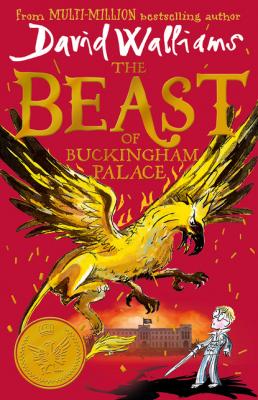The Beast of Buckingham Palace. David Walliams
Чтение книги онлайн.
Читать онлайн книгу The Beast of Buckingham Palace - David Walliams страница 3
 power for all eternity.
power for all eternity.
The sight of a griffin would inspire terror in the hearts of all men. That is why the beasts were used as symbols through the centuries by kings and queens. Griffins can be seen on coats of arms, flags and shields. The message was simple: kneel or you will suffer a terrible fate at the claws of this beast.
It looks a little like a dinosaur, those terrifying creatures that stalked the Earth millions of years ago. However, unlike dinosaurs, no one has ever found the skeleton of one.
But that doesn’t mean that a griffin never lived.
Or one day might not live again…
It was noon, and the sky was black.
There had been darkness over the kingdom for half a century. For, many years before, the people of the Earth had not taken care of their home.
They had burned down all the forests, reducing every last tree to ash.
They had pumped the rivers, lakes and seas full of waste, killing all the fish.
They had dug deeper and deeper under the ground for oil, until the planet was hollow to its core.
Eventually, the Earth took its revenge.
The ice caps of the Arctic and the Antarctic melted. The floods were so mighty that whole countries became submerged underwater.
Violent earthquakes shook entire cities to the ground. All that was left behind were piles and piles of rubble.
Volcanoes erupted, pumping billions of tonnes of ash into the air. Without the sunlight, the crops withered and died. Nothing could grow.
The kingdom was plunged into an ETERNAL WINTER.
It was the only world Alfred knew. He was already twelve years old, but had never, ever seen sunlight. Often, he dreamed how it must have been to feel the sun on your face, or run through a field of tall grass, or swim in a sunlit sea. But it was just that, a dream.
The boy had seen pictures of the sun in books and marvelled at it. A perfect circle of gold. Now the moon and stars had become invisible too. Alfred would spend hours and hours imagining how the night sky must have looked with a thousand little lights twinkling through the blackness.
He was one of those children who liked nothing more than being alone with his imagination. In truth, he had little choice, having been sickly his whole life. Soon after he was born, he became ill. As a baby, Alfred had not been expected to survive, but survive he did.
Just.
The child was as pale as snow and as thin as dust. He wore thick glasses to aid his poor eyesight. Often Alfred was so weak he had to stay in bed all day. Thank goodness all around his bed were piles and piles of books. Books, books and more books. Books about animals. Books about space. Books about trees. Books about dinosaurs. Books about books.
Books about history were his absolute favourite.
The trouble was that there was a strict curfew in the building where Alfred lived. Night was the most dangerous time. That was when there was most chance of an attack from the outside. Lights had to be out at eight o’clock sharp. By order of the King. Anyone caught with lights on would be severely punished. Punishments were brutal in the kingdom. Those in power had returned to medieval forms of torture.
Despite the strict rules, the boy loved his books so much that he would carry on reading by candlelight under his bedcovers…
The night our story begins, Alfred was doing just that. He was reading a weighty leather-bound book about the kings and queens of Britain through the ages. The first known one was Alfred the Great. He had become ruler an impossibly long time ago, in 871. The boy was named after that first king, but it was hard to believe anybody would ever describe this Alfred as “great”. He felt anything but.
As the boy was devouring the story of the beheading of King Charles I in 1649, a deafening sound rocked the room.
KABOOM!
Alfred dropped his book.
THUD!
And his candle. He very nearly set the covers alight.
WOOF!
Smothering the flames and blowing the candle out…
WHOOSH!
…he pulled off his bedcovers.
WHIP!
A huge explosion outside had illuminated the boy’s bedroom with glowing red, orange and yellow light.
Alfred slid out of bed and using all his strength limped over to his huge bay window. Just those few steps left him painfully out of breath.
“Huh! Huh! Huh!”
He leaned on the window frame to steady himself.
Alfred’s bedroom was high up on the top floor. From here, he could see far across London. A building was ablaze. But not just any building.
St Paul’s Cathedral.
This historic structure, perhaps one of the most famous in the world, had been destroyed.
Its huge white dome cracked as if it were nothing more than an egg. Huge plumes of black smoke billowed high into the air.
Oh no! thought Alfred. No! Not St Paul’s!
He had seen many London landmarks destroyed over the years. Nelson’s Column had been toppled to the ground.
CRUNCH!
The London Eye had plunged into the River Thames.
SPLASH!
The Royal Albert Hall roof had caved in after a bomb had blasted it to pieces.
BOOM!
However, none of these was as sacred as St Paul’s. This was a new low. The cathedral had been built after the Great Fire of London in 1666. The glorious structure had miraculously survived the Blitz, when Nazi bombs